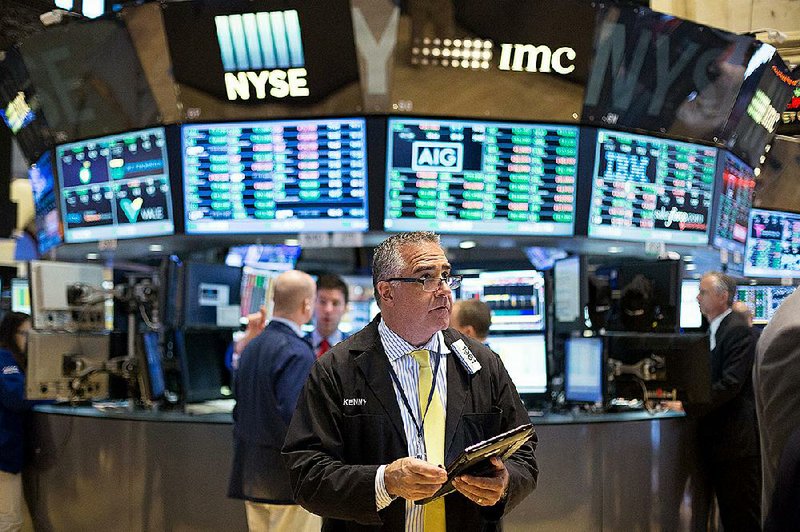WASHINGTON -- U.S. employers added 223,000 jobs in April, helping to ease worries that the economy is entering another extended slowdown after a bleak winter in which the overall economy nearly stalled.
The job growth helped lower the unemployment rate to 5.4 percent from 5.5 percent in March, the Labor Department said Friday. That is the lowest rate since May 2008.
"The pace of employment is quite encouraging," said Gregory Daco, head of U.S. macroeconomics at Oxford Economics USA Inc. "Wage growth is accelerating, but it's quite gradual, more gradual than we would expect in a market where the unemployment rate is 5.4 percent."
The figures provided some reassurance that the economy is recovering from a harsh winter and other temporary head winds that likely caused it to shrink in the first three months of the year. Yet the rebound appears to be falling short of hopes that growth would finally accelerate in 2015 and top 3 percent for the first time in a decade.
Most analysts foresee the economy growing about 2.5 percent this year, similar to the modest expansion typical of much of the 6-year-old recovery.
In its report Friday, the government revised down sharply its estimate of March's job gain to 85,000 from 126,000. In the past three months, employers added 191,000 positions, a decent total but well below last year's average of 260,000.
"Job growth is going from great to good," said Michael Feroli, an economist at JPMorgan Chase.
One reason the economy hasn't accelerated faster is that overseas economic turmoil is still restraining growth. A stronger dollar, which makes U.S. goods more expensive overseas, has cut into factory production. Manufacturers barely added jobs for a second-straight month. And last year's plunge in oil prices led drilling companies to lay off thousands of workers.
The report encouraged investors watching for evidence of an economic rebound from the poor first quarter, but one not so explosive as to cause the Federal Reserve to raise interest rates. The Dow Jones industrial average rose 267.05 points, or 1.5 percent, to 18,191.11.
Many experts once expected the Fed to move in June, but the consensus has recently shifted to September or beyond as the probable beginning of any gradual tightening effort by the central bank.
"All things considered, any lingering possibility of a June rate hike from the Fed is now off the table, with September probably the most likely liftoff date now," said Paul Ashworth, chief U.S. economist for Capital Economics, a research firm.
The unemployment rate is nearing the level the Fed considers healthy. Yet many other signs suggest that the job market isn't fully recovered. The number of full-time workers, for example, fell in April while the number of part-timers jumped more than 400,000 to 27.7 million-- a half-million more than a year ago.
The increase came from Americans who said they preferred part-time work, the report said. The number of part-timers who want full-time jobs declined 100,000 to 6.6 million. That's still above pre-recession levels.
The nation's job growth still isn't raising worker pay much. Average hourly wages rose just 3 cents in April to $24.87. Wages have risen only 2.2 percent over the past 12 months, roughly the same sluggish pace of the past six years.
"We're definitely back to that same discussion we were having before March and earlier this year," said Tara Sinclair, a professor at George Washington University and chief economist at the job-listings service Indeed. "Things are looking pretty good and going in the right direction, but where is the wage growth?"
Corey Bowman, U.S. president of Pita Pit, a 240-store sandwich chain, said his company hasn't had to raise pay even though it's expanding and hiring. Pita Pit plans to add 45 restaurants this year, with each location creating about 15 full- and part-time jobs.
"I haven't noticed any change in terms of what you have to pay to get people," Bowman said.
Other measures of pay that include bonuses are starting to show healthier increases. That trend could reflect pay gains in skilled industries.
Paul McDonald, a director at job-placement firm Robert Half, said companies are offering pay 8 percent to 10 percent higher than a year ago to attract workers in such areas as Web development, computer networking and accounting.
"It really is the age of specialization," McDonald said. "But specialists are hard to find, the demand is so high."
Still, some higher-paying industries, especially those affected by lower energy prices or the higher dollar, are reporting losses. Mining, which includes oil and gas, cut 15,000 jobs in April. The industry has eliminated 49,000 jobs this year, more than offsetting the 41,000 it added in 2014.
Manufacturers added only 1,000 jobs last month after a flat reading in March. That's down from the industry's average monthly job gain of 18,000 last year.
Over the past three months, mining and manufacturing have been subtracting an average of 12,333 jobs a month, said Jay Feldman, U.S. economics director at the bank Credit Suisse.
"I don't think it's enough to stop the recovery," Feldman said. "But it's big enough that it slows the overall pace."
Construction companies, though, picked up much of the slack by adding 45,000 jobs, the most in 16 months. That is a sign that cold weather had held back building projects in March, when the construction industry cut 9,000 jobs.
The economy ground to a near-halt in the first quarter. Federal Reserve policymakers have said some of the forces holding back the U.S. will probably fade and give way to "moderate" growth.
Gross domestic product rose at a 0.2 percent annualized rate after advancing 2.2 percent in the previous quarter, Commerce Department data showed last month.
Information for this article was contributed by Christopher Rugaber Josh Boak and Paul Wiseman of The Associated Press; by Victoria Stilwell and Chris Middleton of Bloomberg News; and by Nelson D. Schwartz of The New York Times.
Business on 05/09/2015
